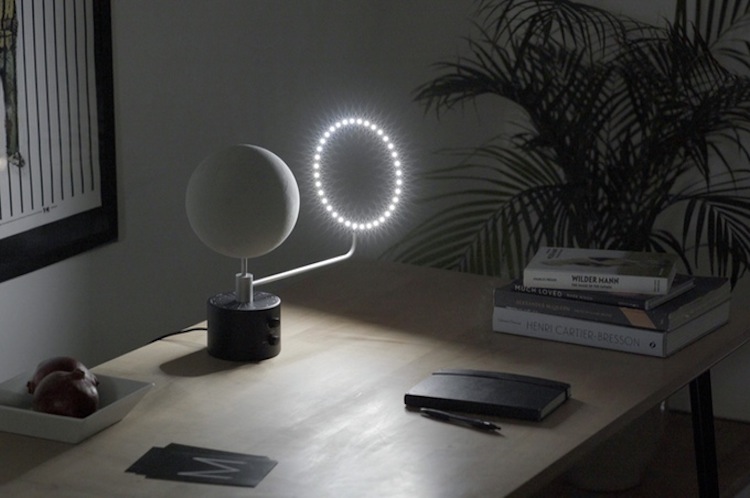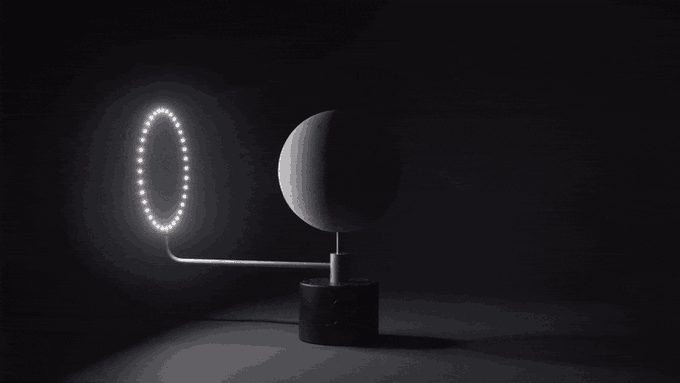
Take the Moon Home with Incredibly Detailed Lunar Globe

If you want a nice view of the moon, instead of squinting into the night sky or cursing tall buildings, you could soon gaze at an expertly crafted model of the stunning celestial object. And this version is small enough sit atop your coffee table.
The lunar globe, dubbed MOON, bills itself as the most accurate of its kind. Its makers used NASA data to re-create the moon's many craters, including Petavius and Copernicus, at 1/20,000,000th the original size. The mini moon comes with a ring of LED lights that revolve around the globe and illuminate the face of the moon as seen from Earth.
MOON also reveals the far side (sometimes referred to as the "dark side") of the moon, which faces away from Earth. This mysterious lunar region is even more pockmarked with craters than the Earth-facing side is, said Oscar Lhermitte, creator of MOON. "It’s quite stunning," he said. [Top 10 Amazing Moon Facts]
The road to building MOON began four years ago, Lhermitte, a French industrial designer based in London, told Live Science. He was inspired to create MOON after he saw high-resolution photos captured by NASA's Lunar Reconnaissance Orbiter (LRO), which has been in orbit around the moon for almost seven years. The LRO probe collects information on the lunar environment, maps day and night temperatures, and snaps high-resolution images of the moon.
Lhermitte reached out to the German Aerospace Center's Institute of Planetary Research, which worked on the LRO mission, and obtained access to the institute's extensive database of 2D lunar photos.
In order to transfer the 2D, black-and-white photos onto a 3D globe, Lhermitte converted the images into "digital terrain models," he said. The models assigned values of elevation for shades of grey; for instance, anything that was 100 percent white would be designated as the lowest point and anything that was 100 percent black would be designated as the highest point. Varying shades between black and white then correlated to varying elevations, which gave rise to a topographic, bumpy surface, Lhermitte said.

Once the 3D data was ready to be imprinted on the globe, Lhermitte had to export the unusually dense file (typical 3D printing jobs are about 1 megabyte, but this 3D printing job was about 4 gigabytes), he said. And he had to hope his computer wouldn't crash, Lhermitte said. He printed a full model of the moon using an industrial nylon (a white, robust plastic) 3D printer; this model is now the master, or the model from which subsequent molds are made. The master's outer layer is 0.004 inches (0.1 millimeters) thick.
Sign up for the Live Science daily newsletter now
Get the world’s most fascinating discoveries delivered straight to your inbox.
Each globe is made with hard polyurethane resin, a common casting material, and pigmented to reflect the moon's greyish color. Since people "only recognize craters when the light shines on them," Lhermitte said, MOON also comes with a rotating light source controlled by a mini, internal computer.
Lhermitte's colleagues, Alex Du Preez and Peter Krige, designed the computer to include an algorithm that calculates the path of the moon around the sun for the next 100 years. The computer also contains a clock that will sync itself with the accurate time and phase of the moon once plugged in, Lhermitte said. As a nod to lunar enthusiasts, "The MOON's clock has the same memory capacity (64 kilobytes) as the computers used for [the] Apollo 11" mission in 1969, he added.
Lhermitte said he hopes to see his creation used in school classrooms, science museums and observatories in the near future. He is currently creating two sizes of MOON; one model is smaller and contains the revolving light source and the other is larger and does not come with a light source. The smaller model is 1/20,000,000th the moon's original size and measures 6.8 inches (17 centimeters) across, and the larger model is 1/11,500,000th the moon's original size and measures 11.8 inches (30 cm) across.
The project raised more than $210,000 through a crowdfunded Kickstarter campaign, well beyond the original stated goal of $36,201. The project is now available for pre-order through Kickstarter, with the smaller version (which includes lights) currently selling for about $870 and the larger version (which lacks the ring of LED lights) currently going for $800. Both versions of the lunar globe will begin shipping pre-orders in November.
Original article on Live Science.










